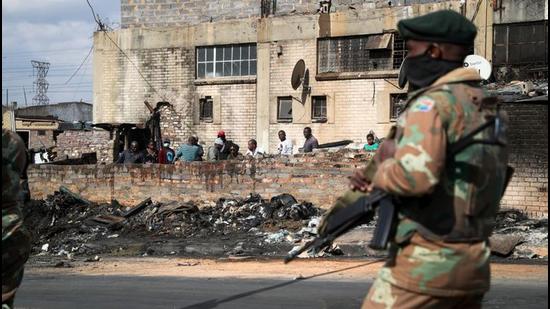From India, a note of concern about South Africa
That Nelson Mandela’s rainbow nation should have to experience a dance of death with fire — spewed from petrol bombs — being its chosen weapon, is not something that the world expected
South Africa rocked by mass violence? Over 300 dead, shops gutted, highways blocked, and trucks set ablaze? Hard to believe, even harder to accept.

That Nelson Mandela’s rainbow nation should have to experience a dance of death with fire — spewed from petrol bombs — being its chosen weapon, is not something that the world expected. In July, the country was gripped by violence and rioting, with the armed forces being deployed in several regions to quell protests and bring back a sense of calm.
Analyses of the causes and the nature of the flash are cautious and tentative, for observers are not quite sure yet if President Cyril Ramaphosa will be able to control the situation or not. Crossed fingers do not write easily. And yet, some meaning has to be made out of the situation.
Why?
Former President Jacob Zuma (79) is central to the “why”. In his rise to the nation’s presidency in the mid-2000s, KwaZulu Natal saw itself at the pinnacle of power in the new South Africa. However, in his recent trial and arrest, that gradient was seen and portrayed by his supporters as having tilted down. This is where the “why” becomes crucial.
Not everyone in KwaZulu Natal has been enraged by the turn in the former president’s fate. With details of accusations of corruption piling up, South Africa saw a sign of “no one is so high as to be higher than justice”.
Then, why the blood and bedlam?
With inequalities reigning and riling the poor, and Covid-19 sharpening the endemicity of misery into an epidemic of hitherto unknown scale, South Africa was already afflicted. But areas with high concentrations of Zuma supporters now had something else that could be added to the crisis — a sense of being wronged. And in this, political players saw an opportunity and used it. As Greg Arde wrote in a South African online newspaper, Daily Maverick, on August 2, “It was as though the unrest became a lightning rod for frustration around many things.”
Also Read | Black Sunday in Africa: 51 die in Mali attacks, 12 troops killed in Burkina Faso
How?
The violence did not erupt “just like that”, as in some seismic happening. Close observers of the South African scene believe that KwaZulu Natal, where most of the violence for over three days has been located, the areas of Gauteng and Mpumalanga would not have reacted as they have, had it not been for political players, chagrined by Zuma’s fate and liable to lose out by his imminent jailing, orchestrating the unrest — with deadly invisibility. A group, violent in intent and adept in the methods of violence, focused on enriching itself through the capture of State resources and key ministries, and swiftly and skillfully got into the act of planning retaliation to the process of law. The Zondo Commission on State Capture, a public inquiry launched by Zuma, points to this.
The whole process starting with roadblocks, the burning of trucks on the highway, the looting of supermarkets and malls, then factories and industry, and later, warehouses and key installations such as oil manufacturing plants was not the work of poor people suddenly angered. Strategists with ground-level operatives, using a group of criminal elements — a familiar pattern in India — planned the havoc with technological prowess and precision, and used the poor to come in and do the actual looting.
Affected communities organised themselves into vigilante groups to safeguard their neighbourhoods through street watches and the like, only to be infiltrated by criminal elements who then got the vigilantes to go beyond self-defence and attack people, with some 20 people reportedly killed. Which is when the term “ethnic” was given to the riots. And “racism” was heard.
Kwazulu Natal as a whole did not back the violence. The Zulu king and Inkatha veteran Mangosuthu Buthelezi distanced themselves from the grim happenings. It is important to note this.
As an uneasy and traumatised calm returns, we ask, “What does the future hold for that great country?” At the time of writing, no one can answer that with confidence.
Two serious issues need to be considered. First, the opportunities given by freedom have been used by some in South Africa’s new elite to turn iron handcuffs into gold cufflinks. This is tragic and dangerous.
Second, while it would be factually wrong and unjust to dub these tragic events as “ethnic”, who can deny that fault-lines exist in South Africa, as they do in South Asia, and can be deepened, sharpened, and exploited?
The poor are invariably co-opted by power-seekers who then glide out of sight. Hope lies in President Ramaphosa restoring order by immobilising the inciters. And there is another great sign of promise.
Communities all over are now coming together to work on peace processes without waiting for the government to show the way. The trauma has awakened a spirit among the people to work towards a togetherness that transcends ethnic boundaries.
South Africa is meant for healing, not hate. For greatness, not greed.
Gopalkrishna Gandhi is a former administrator, diplomat and governor
The views expressed are personal
All Access.
One Subscription.
Get 360° coverage—from daily headlines
to 100 year archives.



HT App & Website






